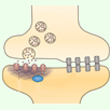Saturday, 14 March 2015
The “Coming Out” of the Electrical Synapse

The first living organisms composed of more than one cell first appeared on Earth slightly over 3 billion years ago. Once they did, the need arose for all of the cells in each organism to co-ordinate their efforts toward a single goal: the survival of the organism as a whole. To do so, these cells began secreting molecules that, by binding to the surface of other cells, informed them about what was happening elsewhere in the organism.
That, in short, is the origin not only of the human hormonal system but also of human synapses: the connections between nerve cells. In general, when people talk about synapses, they are referring to chemical synapses, into which neurotransmitters are released by the presynaptic neuron, then migrate across a space measured in nanometres to bind to receptors on the postsynaptic neuron on the other side.
But there is another category of synapses as well: electrical synapses. And an article published in the journal Nature Reviews Neuroscience in March 2014 reports that electrical synapses are far more widespread in the human brain than was formerly believed. The article also says that chemical and electrical synapses interact extensively, both during the development of children’s nervous systems and in adult human brains, and that electrical synapses are every bit as complex and plastic as chemical synapses.
In short, the description of electrical synapses in this article is surprising to say the least for anyone who remembers how they are described in traditional biology textbooks: as simple molecules juxtaposed to form a kind of rivet with a channel through its centre, known as a gap junction, that lets small charged molecules pass freely and directly from the inside of one neuron to the inside of another. Gap junctions are regarded as fast but inflexible bidirectional connections. In contrast, chemical synapses are generally considered to have all the plasticity of the neural circuits that are the basis for human learning.
Over the past 10 to 15 years, however, there has been growing evidence that electrical synapses play a far more important role in neuronal communication than was once believed. For one thing, they are thought to enable large numbers of neurons to synchronize their activities, as each neuron takes the excitatory signals that it receives and distributes them to the neighbouring neurons to which it is connected by electrical synapses. Thus these synapses would facilitate the neuronal synchronization on which several fundamental functions of the human brain depend.
The efficiency of electrical synapses, and hence the ease with which small charged molecules can pass across them, is also proving to be at least as modulable as that of chemical synapses. Just as a neurotransmitter receptor can be modified to strengthen a chemical synapse, the connexin molecules that form electrical synapses can be modified to increase or decrease their porosity.
There are even connexin-modulating substances, such as dopamine, that, when secreted by other neurons some distance from the electrical synapse, bind to specific receptors, thereby activating biochemical reactions that can modify that synapse’s efficiency.
The picture has become even more complicated with the discovery of mixed synapses, in which a chemical component and an electrical component occur in a single synaptic region. Another complex phenomenon is the interaction between electrical and chemical synapses during embryonic development, in which the electrical activity in the electrical synapses of the brain’s neural networks allows the chemical synapses to gradually become established.
In the end, the two types of synapses must be seen far less as separate and far more as indissociable, somewhat like matter and energy in physics.
![]() Electrical Synapses Are Critical for Chemical Synapse Function
Electrical Synapses Are Critical for Chemical Synapse Function
![]() Electrical synapses and their functional interactions with chemical synapses
Electrical synapses and their functional interactions with chemical synapses
From the Simple to the Complex | Comments Closed







